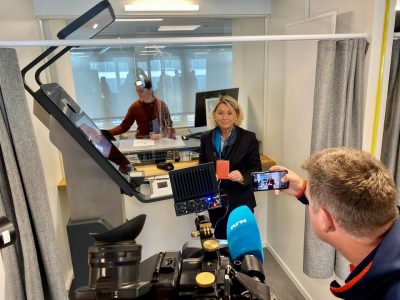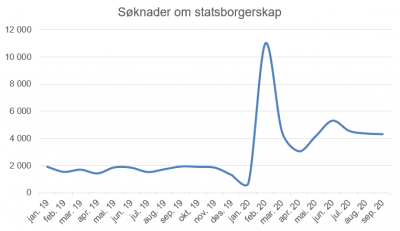Permanent foreign residents now eligible for dual citizenship in Norway have become surprised, frustrated and even angry over how difficult and time-consuming the process has turned out to be. Lengthy delays at the state police unit dealing with immigration issues are also dashing applicants’ hopes of being able to vote for the first time in next autumn’s national election.

Norway was one of the few countries in the world that contro-versially did not allow dual citizenship until it was formally approved from January 1 of this year. A majority in Parliament had cleared the way for it, however, in late 2018, giving both state immigration agency UDI (Utlendings-direktoratet) and the police unit that enforces immigration law (Politiets Utlendingsenhet) just over a year to prepare what was expected to be a wave of applications.
Both UDI and the police, however, seem to have vastly underestimated just how high that wave would be. Newspaper Aftenposten reported over the weekend that around 46,500 permanent legal residents of Norway had applied just between January 1, when the new law formally took effect, and October. The number includes applications for both ordinary citizenship and dual citizenship, but it’s reportedly more than triple the number of citizenship applications submitted in what Aftenposten called “a normal year.”
Now those stuck in the citizenship queue, who have had to pay nearly NOK 5,000 (USD 555) in citizenship-related fees, are having to wait until as long as August of next year or beyond just for the mandatory meeting with police to deliver their application and necessary documents. Once their paperwork is approved, the police then forward copies of all documents to UDI for processing. That, according to the police, can take up to another year if the application is processed manually, less time if it goes through a new electronic process, but it was plagued by bugs when introduced earlier this year.
Unprepared
Those keen to secure dual citizenship in Norway, especially after a majority voted in favour of it December 2018, were actually advised during the course of 2019 to wait to apply until January 1, 2020. That was because UDI was set to introduce the new electronic system to handle dual citizenship applications. It was supposed to function much more quickly than the manual citizenship process.
The new system, however, was not up and running as promised in early January after all. UDI apologized for the delay, blaming technical difficulties. When the new system finally debuted in mid-February, it crashed after around 1,700 eager would-be citizens tried to access it.
Disappointed applicants were finally able by late February to complete and pay for their citizenship applications online, make an appointment with the police to deliver their documents, apply for certification from the police that they hadn’t committed any crimes, and apply to take the now-mandatory citizenship test. That could take another two- to three months, meaning the actual approval process would begin by early summer.

Then came Corona. Citizenship tests, which also carried a fee, were abruptly cancelled as were the most important meetings with the police. While citizenship tests were eventually resecheduled automatically, the police meetings were not. The burden was on every individual applicant to constantly click into the police website until its office for immigration issues (Politiets utlendingskontor) opened up again after the initial Corona crisis.
The police website, when it finally reopened, didn’t start offering scheduled appointments until August, and by then the backlog was huge. Applicants managing to get through even in late June to book an appointment with police in Oslo (where capacity and demand is highest) weren’t offered dates until mid-November. Those trying to book now are having to wait until late next year, and thus likely won’t be able to vote in the September 2021 election.
“The waiting time is long in all police districts (around Norway) because the number of these cases is considerably higher than there was reason to expect,” Fredrik Strøm, leader of the police’s immigration service, claimed in an email to Aftenposten.
There were, however, 790,497 immigrants in Norway as of January 1, according to state statistics bureau SSB (Statistics Norway). SSB also reports that 138,470 immigrants received Norwegian citizenship from 2010 and 2019. That suggests a lot of other immigrants who remain foreign nationals, perhaps because they would have had to give up their own citizenship in order to gain Norwegian citizenship. Now they can have both, and tens of thousands clearly want both.
Underestimated demand
It’s puzzling why the Norwegian immigration authorities did not think so many people would want to become citizens. It arguably reflects well on Norway as a place to live, but seems to have caught both UDI and the police off guard, and overloaded their capacity. Aftenposten reported that the police had around 8,800 would-be citizens on a waiting list in November, a number that’s likely to rise as more expats in Norway apply. Police accepted a total of 3,077 applications for processing between August and November.
The situation clearly frustrates applicants like Johannes Anker, who has a Danish father and Norwegian mother and has lived in Oslo with only his Danish passport. Aftenposten reported that Anker was among those eager to apply for a Norwegian passport in January and finally could in February. Then came the Corona delays and the difficult process of getting an appointment with police. His date is now in August 2021.
“I have lived nearly my entire life in Norway, I feel like I’m Norwegian, I pay tax here,” Anker told Aftenposten. Like all other permanent residents, he’s also entitled to most all rights and obligations of Norwegian citizens, except the right to vote in national elections.
Loss of confidence in the system
“Now I want to exercise the right to vote,” Anker told Aftenposten, while realizing that by having to wait until August next year, it will be too late to vote in the September election. The next national election won’t be held until 2025. The delay, unwarranted in many respects, makes him feel like Norway is now rejecting him, after all these years.
“I believe in the mutual confidence that’s Norway’s gold, the confidence that we who live here can rely on the system, rely on the authorities,” he told Aftenposten. “That confidence is broken when it applies to me. There are many others who are in a much worse situation than me as a white Scandinavian man, but it just doesn’t feel right.”
Linda Kartawich, head of citizenship issues at UDI, also told Aftenposten that the number of citizenship applications “increased more than expected” when dual citizenship became legal. She argues that UDI prepared for changes well in advance and developed an automatic system for applications that’s aimed at cutting down the average 12-month waiting time. NOK 4.7 million (around USD 500,000) in extra funding was allocated to help facilitate the changes.
“But the prognoses regarding how many would apply were unclear,” Kartawich said. The police claim they warned there would be “extra challenges” in handling applications, but Strøm says the police were not allocated extra resources.
More funding may help
Norway’s justice ministry is ultimately responsible for both UDI and the police, but in this case, the education ministry that’s responsible for integration of immigrants had erroneously determined that demand for citizenship would be “moderate.”
Grunde Almeland, state secretary in the education ministry, told Aftenposten that’s why no additional funding was considered needed. Now, with the police and UDI totally overburdened, there are firm proposals to allocate more resources. A total of NOK 61.5 million (USD 7 million) is likely to be earmarked for citizenship applications in the new state budget, with NOK 25 million going to UDI and 36.5 million to the police. In addition comes the NOK 3,700 fee paid by around 46,500 people so far.
That may pare down waiting lists but it remains uncertain how many applications will or can be handled in in 2021. In addition to all those applying for Norwegian citizenship for the first time come many expatriate Norwegians who had to give up their Norwegian citizenship when they obtained citizenship in the countries where they live. Many want their Norwegian citizenship back and are applying for it as well, often from abroad. Processing time now depends on developments at Norway’s foreign embassies and consulates, at the police offices in Norway and, not least, on the pandemic.
NewsInEnglish.no/Nina Berglund
(EDITOR’S NOTE: The writer is also going through the citizenship process and can confirm lengthy delays.)

